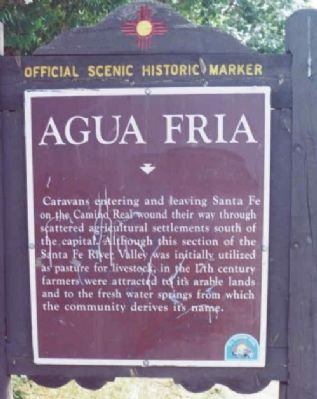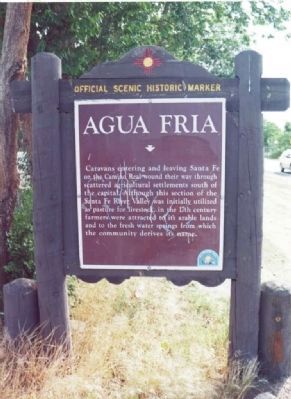Agua Fria Village in Santa Fe County, New Mexico — The American Mountains (Southwest)
Agua Fria
Erected 1960 by State Highway Department.
Topics and series. This historical marker is listed in these topic lists: Agriculture • Hispanic Americans • Roads & Vehicles • Settlements & Settlers. In addition, it is included in the El Camino Real de Tierra Adentro series list.
Location. 35° 39.609′ N, 106° 0.252′ W. Marker is in Agua Fria Village, New Mexico, in Santa Fe County. Marker is on Agua Fria Street (El Camino Real) (County Road 66) 0.2 miles west of Siler Road, on the right when traveling east. Marker is located in front of Agua Fria Elementary School (Agua Fria Street is also known as Old State Road 22). Touch for map. Marker is at or near this postal address: 3160 Agua Fria Street, Santa Fe NM 87507, United States of America. Touch for directions.
Other nearby markers. At least 8 other markers are within 4 miles of this marker, measured as the crow flies. San Isidro Catholic Church (here, next to this marker); Santa Fe (approx. 1.2 miles away); Fairview Cemetery (approx. 2.8 miles away); Marian Myer (approx. 2.8 miles away); Agricultural History (approx. 3.2 miles away); Acequia Madre (approx. 3.3 miles away); Railyard History (approx. 3.4 miles away); The Spiegelberg Brothers (approx. 3.4 miles away).
More about this marker. Replaced after road construction in 1999 and text was temporarily lost.
Regarding Agua Fria. Agua Fria Village has been designated as a "Traditional Historic Community" in 1995 by Santa Fe County as allowed by state statute.
http://www.co.santa-fe.nm.us/community_services/community_planning_center#aguafria
So this might be considered a political subdivision.
And was named as one of America's most endangered places in 2004:
http://www.nmhistoricpreservation.org/documents/55.DOCUMENT.pdf
Additional commentary.
1.
Agua Fria Village became a place of modern recorded settlement in New Mexico when Sergeant Major (Maestro Campo) Roque Madrid was given a land grant on the Santa Fe River from Ojito Fresco to Pueblo Quemado in 1693 by General Don Diego de Vargas for his service in the 1692 “Reconquest” of New Mexico by the Spanish Crown. His request was granted based on his parents and grandparents having farmed this area prior to the revolt. Other land grants were given to other soldiers and the ditches from the Santa Fe River (acequias) were extended and carried precious water to the flat lands of Agua Fria, which had been used for farming for centuries. Eventually, this small community became the breadbasket of the City of Santa Fe.
The individual grants of the Agua Fria Village residents went from the Arroyo de los Chamisos (near the present day Santa Fe Place Mall) to the Arroyo de los Frijoles or the southern most boundary of the San Ildefonso Pueblo grant; a distance of some five to seven miles in length. Lots were narrower in width and may have been only 600 to 900 feet (200 or 300 yards or “varas”).
Santa Fe was established in 1609 and the settlements developed in the city as well as surrounding areas, among them Agua Fria. The settlers lived and made their homes from the resources of the earth. They were farmers and sustained their families from the crops and animals they raised with the generosity of water from the Santa Fe River. The Santa Fe River was the focal point in establishing themselves in this region. Faith, farming and home remedies were the only means of survival.
In the beginning of the settlements Cieneguitas, Agua Fria and Cieneguilla were called Ranchitos, as the population grew Agua Fria became a Placita. Agua Fria was identified by two groups. The area by the Church was "La Placita de Los Romeros and the other one in the area of the Tanque "watering hole" (area of Lopez and Camino de Oro Road) "La Placita de Los Lopez".
As the community grew, it acquired the status of a Village.
In the year, 1776 Fray Francisco Atanacio Dominguez gave a census count to his superiors listing Agua Fria with 57 families and 297 persons.
(The first four paragraphs above are from the collected works of Melinda Romero Pike, first published in the People of God newsletter of May 2010, by the Archdiocese of Santa Fe on the 175th anniversary of San Isidro Catholic Church).
— Submitted January 1, 2011, by William H Mee of Santa Fe, New Mexico, usa.
Credits. This page was last revised on June 16, 2016. It was originally submitted on December 27, 2010, by William H Mee of Santa Fe, New Mexico, usa. This page has been viewed 9,491 times since then and 47 times this year. Last updated on February 22, 2011, by William H Mee of Santa Fe, New Mexico, usa. Photos: 1, 2. submitted on December 27, 2010, by William H Mee of Santa Fe, New Mexico, usa. • Syd Whittle was the editor who published this page.

